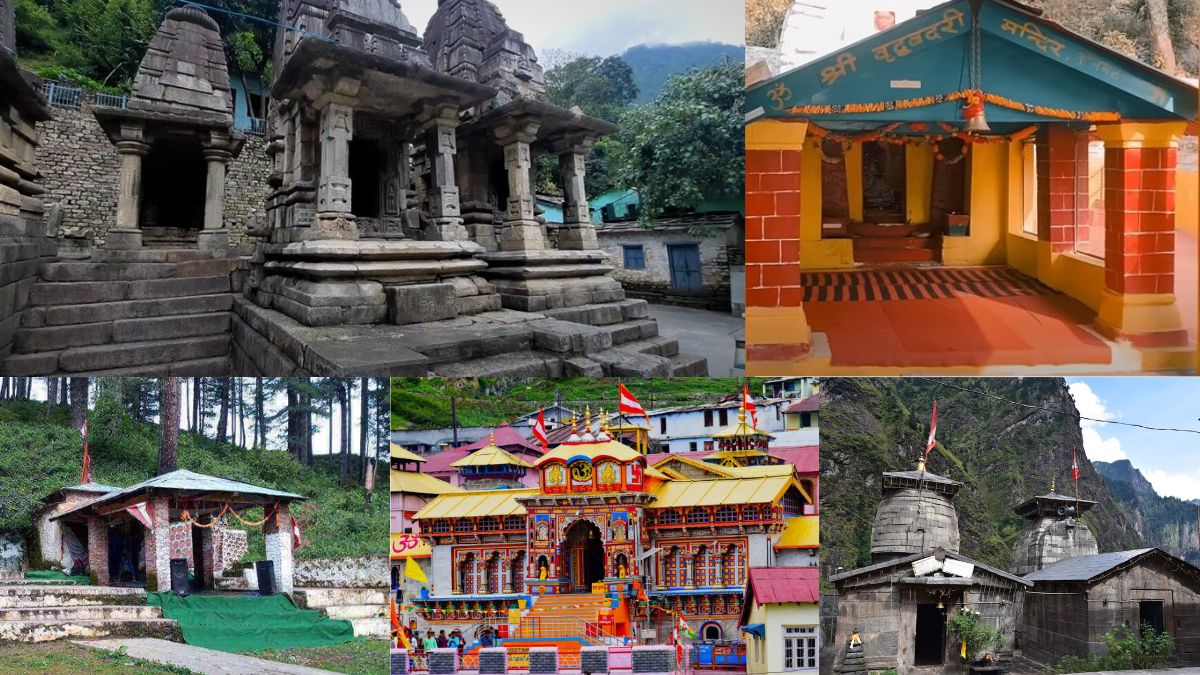The Panch Badri Yatra is an awe-inspiring pilgrimage circuit in the Indian Himalayas, encompassing five sacred temples dedicated to Lord Vishnu, collectively known as the Badri temples. Located in the Garhwal region of Uttarakhand, this yatra offers devotees a profound spiritual experience, with each temple representing different aspects of Lord Vishnu. This guide provides a detailed overview of the Panch Badri Yatra, including its significance, planning tips, and essential information to ensure a smooth and spiritually enriching journey.
1. Understanding the Panch Badri Yatra
Significance of the Five Temples
- Badrinath: The primary and most renowned temple in the Panch Badri circuit, Badrinath, is dedicated to Lord Vishnu in his Badri form. Situated at an altitude of 3,133 meters (10,279 feet), it is one of the Char Dham pilgrimage sites and is revered for its spiritual significance. The temple is known for its idol of Lord Vishnu, made of Shaligram stone, and its breathtaking location along the banks of the Alaknanda River.
- Yogadhyan Badri: Located at an altitude of 1,920 meters (6,300 feet) in the village of Pandukeshwar, Yogadhyan Badri is dedicated to Lord Vishnu in a meditative posture. This temple is believed to be the site where Lord Vishnu meditated before the Mahabharata war.
- Adi Badri: Situated at an altitude of 1,370 meters (4,490 feet), Adi Badri is the first temple in the Panch Badri circuit and is believed to be the place where Lord Vishnu appeared in his early form. The temple is located in the village of Adi Badri and is surrounded by lush greenery and serene landscapes.
- Bridh Badri: Positioned at an altitude of 1,500 meters (4,920 feet) in the village of Karna Prayag, Bridh Badri is dedicated to Lord Vishnu. It is believed that Lord Vishnu, in his older form, resides here, and the temple is an important site for devotees seeking blessings for longevity and wisdom.
- Jai Badri: Located in the village of Nandprayag at an altitude of 1,800 meters (5,900 feet), Jai Badri is dedicated to Lord Vishnu and is known for its peaceful surroundings. This temple is less frequented compared to the others but holds significant religious importance.
2. Planning the Panch Badri Yatra
Best Time to Visit
- Summer Season (May to June): The ideal time for the Panch Badri Yatra is between May and June when the weather is pleasant, and the roads and trekking paths are accessible.
- Autumn Season (September to October): Another good time to undertake the yatra is during the autumn months when the weather is clear, and the trails are in good condition.
Duration and Itinerary
The Panch Badri Yatra typically spans around 12 to 15 days, depending on the pace and weather conditions. A common itinerary might look like this:
- Day 1-2: Arrival in Dehradun/Haridwar and travel to Adi Badri.
- Day 3-4: Adi Badri to Yogadhyan Badri.
- Day 5-6: Yogadhyan Badri to Bridh Badri.
- Day 7-8: Bridh Badri to Jai Badri.
- Day 9-11: Jai Badri to Badrinath.
- Day 12: Return to Haridwar/Dehradun.
- Day 13: Departure.
Choosing the Right Travel Agency
- Specialized Agencies: Opt for travel agencies that specialize in Panch Badri Yatra. They can handle logistics, permits, and accommodations efficiently.
- Reputation: Choose agencies with good reviews and a track record of managing pilgrimages.
- Package Inclusions: Ensure the package includes transportation, accommodation, meals, guides, and permits.
Permits and Documentation
- Permits: Obtain necessary permits for visiting the temples, especially if you are traveling to remote areas.
- Identification: Carry valid photo identification and any required medical documentation for high-altitude travel.
3. Preparing for the Panch Badri Yatra
Health and Safety
- Medical Check-Up: Ensure all participants undergo a medical check-up before the trip to address any potential health issues.
- Travel Insurance: Obtain comprehensive travel insurance covering medical emergencies, trip cancellations, and other unforeseen events.
Packing Essentials
- Clothing: Pack warm and waterproof clothing. Include thermal wear, waterproof jackets, gloves, hats, and layers suitable for varying weather conditions.
- Footwear: Sturdy trekking boots with good grip are essential for navigating rocky and uneven terrain.
- Gear: Include a reliable backpack, trekking poles, a sleeping bag, and personal toiletries.
- First-Aid Kit: Carry a well-stocked first-aid kit with medications for altitude sickness, pain relief, and personal health needs.
Health Precautions
- Altitude Sickness: Be aware of symptoms such as headaches, nausea, and dizziness. Proper acclimatization, hydration, and avoiding overexertion are crucial.
- Hygiene: Maintain good hygiene to prevent infections. Use bottled water and avoid consuming raw or uncooked food.
4. The Panch Badri Yatra Experience
Day 1-2: Arrival in Dehradun/Haridwar and Travel to Adi Badri
- Arrival: Arrive in Dehradun or Haridwar and check into your accommodation. Rest and prepare for the journey.
- Travel to Adi Badri: Depart for Adi Badri by road. The journey involves driving through scenic mountain routes.
- Temple Visit: Visit the Adi Badri Temple, explore the surroundings, and soak in the serene environment.
Day 3-4: Adi Badri to Yogadhyan Badri
- Travel to Yogadhyan Badri: Drive from Adi Badri to Yogadhyan Badri. The route offers beautiful views of the Himalayas.
- Temple Visit: Visit the Yogadhyan Badri Temple, dedicated to Lord Vishnu in a meditative posture. Enjoy the tranquil surroundings and the spiritual ambiance.
Day 5-6: Yogadhyan Badri to Bridh Badri
- Travel to Bridh Badri: Drive to Bridh Badri, located in Karna Prayag. The journey includes traversing through picturesque landscapes.
- Temple Visit: Visit the Bridh Badri Temple and seek blessings for longevity and wisdom. Take time to reflect and appreciate the peaceful setting.
Day 7-8: Bridh Badri to Jai Badri
- Travel to Jai Badri: Drive to Jai Badri in Nandprayag. The route provides stunning views of the confluence of rivers and the surrounding valleys.
- Temple Visit: Visit the Jai Badri Temple, dedicated to Lord Vishnu. Enjoy the serene environment and the spiritual significance of the site.
Day 9-11: Jai Badri to Badrinath
- Travel to Badrinath: Depart for Badrinath, the main highlight of the yatra. The journey involves driving through scenic routes.
- Temple Visit: Visit the Badrinath Temple, dedicated to Lord Vishnu. Explore the temple complex, take a holy dip in the Tapt Kund (hot spring), and visit nearby attractions such as the Mana Village and the Saraswati River.
Day 12: Return to Haridwar/Dehradun
- Return Journey: Depart from Badrinath and travel back to Haridwar or Dehradun. Check into your accommodation and relax.
- Explore: If time permits, explore local attractions in Haridwar or Dehradun.
Day 13: Departure
- Departure: Check out of your hotel and depart for your onward journey.
5. Group Dynamics and Coordination
Managing Group Dynamics
- Leadership: Appoint a group leader or coordinator to manage logistics, schedules, and communication.
- Communication: Ensure clear communication within the group regarding daily schedules, meeting points, and any changes in plans.
- Flexibility: Be prepared for unforeseen changes and maintain flexibility in the itinerary.
Cultural Sensitivity
- Respect Local Traditions: Educate the group about local customs, dress codes for temples, and proper behavior during the pilgrimage.
- Environmental Responsibility: Practice environmental responsibility by minimizing waste and respecting natural surroundings.
6. Budgeting for the Panch Badri Yatra
Costs
- Travel Package: Costs typically include transportation, accommodation, meals, and permits. Group discounts may be available.
- Accommodation: Budget for stays in hotels or guesthouses at each destination.
- Meals: Include the cost of meals during the journey, either as part of the package or individually arranged.
- Additional Expenses: Account for additional expenses such as souvenirs, extra activities, and personal items.
Managing Finances
- Group Funds: Consider pooling funds for group expenses and managing them through a designated treasurer or coordinator.
- Payment Methods: Carry a mix of cash and cards, but be aware that ATMs may be limited in remote areas.
7. Safety and Emergency Preparedness
Emergency Contacts
- Local Authorities: Keep contact information for local authorities, medical facilities, and emergency services handy.
- Travel Agency: Maintain communication with your travel agency for assistance in case of emergencies.
Health Precautions
- First-Aid: Ensure the group has a well-stocked first-aid kit and knowledge of basic first-aid procedures.
- Medical Assistance: Be aware of the nearest medical facilities and emergency evacuation procedures in case of serious health issues.
8. Environmental and Cultural Etiquette
Environmental Responsibility
- Leave No Trace: Carry all waste back with you and dispose of it properly. Avoid littering and respect the natural environment.
- Wildlife Protection: Do not disturb or feed wildlife. Maintain a safe distance and respect their natural habitat.
Cultural Respect
- Temple Etiquette: Follow proper dress codes and etiquette when visiting temples. Remove shoes before entering temple premises and avoid loud behavior.
- Local Customs: Be respectful of local customs and traditions. Engage with local communities in a respectful and considerate manner.
9. Conclusion
The Panch Badri Yatra is a journey of deep spiritual significance and scenic beauty, offering devotees a unique opportunity to connect with Lord Vishnu through his various forms. By carefully planning and preparing for the trip, you can ensure a smooth and enriching pilgrimage experience that fosters spiritual growth and personal reflection.
From navigating the mountainous terrain and managing group dynamics to respecting cultural and environmental norms, every aspect of the Panch Badri Yatra contributes to a memorable and transformative journey. Embrace the pilgrimage with reverence and gratitude, and cherish the spiritual and personal insights gained along the way.









